Joint Venture Passenger Car Brands’ ADAS and Autonomous Driving Research Report, 2021
Joint venture brands’ ADAS research: the installations of L2 ADAS surged by 43.2% year on year.
In the first eight months of 2021, 3.87 million passenger cars of joint venture brands in China were equipped with ADAS, a like-on-like jump of 25.4%, with the installation rate up to 49.0%, up 4.9 percentage points. Wherein, the installations and installation rate of L2 ADAS increased by 43.2% and 5.1 percentage points from the same period of the previous year, separately.
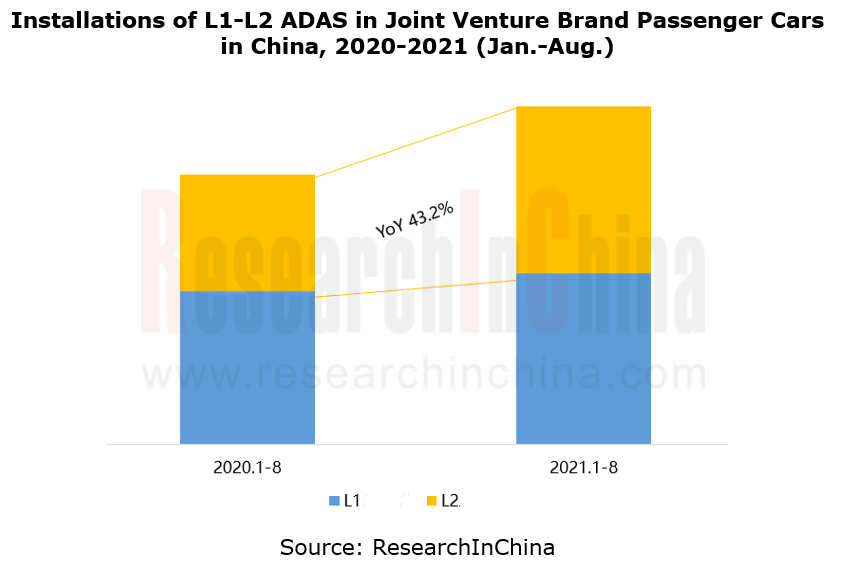
Toyota leads L2 ADAS market.
In the joint venture brands’ L2 ADAS market, Toyota is only first-echelon player, with the system installations far higher than its peers; Honda, Buick, Volvo and Tesla are in the second echelon.
- Toyota’s installations of L2 ADAS approached 700,000 units, driven by its hot-selling models like Corolla, Levin, RAV4 and Avalon, nearly 400,000 units more than the runner-up Honda. In terms of sensor solution, Toyota’s L2 ADAS adopted 1R1V and 3R1V solutions, over 90% of which were 1R1V;
- Volvo boasted a L2 ADAS installation of 95.6% and mainly used 1R1V and 3R1V solutions, of which 1R1V swept over 80%;
- The third-echelon players, Ford and Volkswagen have the potential to leap to the second echelon.
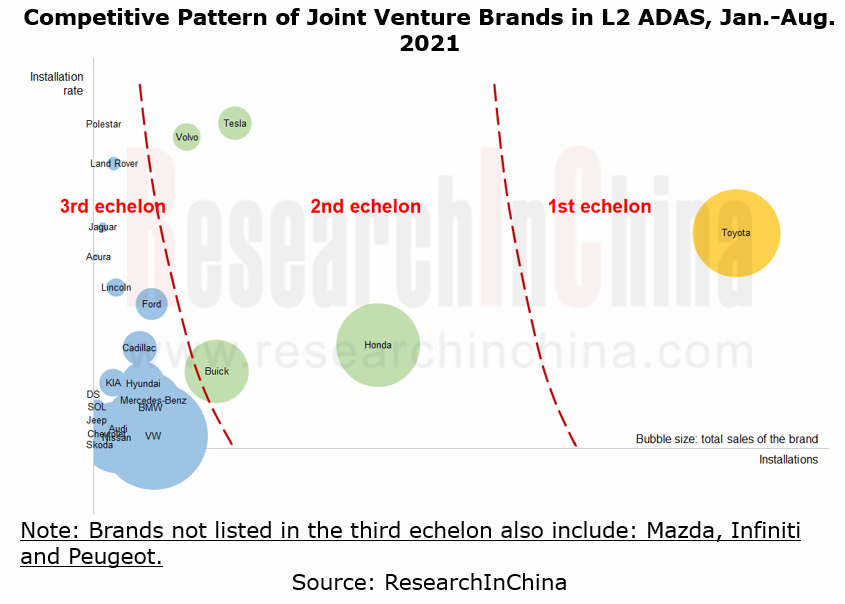
L3 ADAS of Honda and Mercedes-Benz has been approved for use in cars legally introduced on roads in their local markets.
In March 2021, Honda introduced Honda SENSING Elite, a L3 automated driving system first mounted on Honda Legend, the world’s first L3 model legally introduced on roads. This L3 system employs the following sensor solution:
- 1 set of front view stereo cameras
- 4 surround view cameras
- 5 LiDARs (Valeo’s second-generation SCALA LiDARs, 16-channel)
- 5 radars
The sensor layout is shown below.
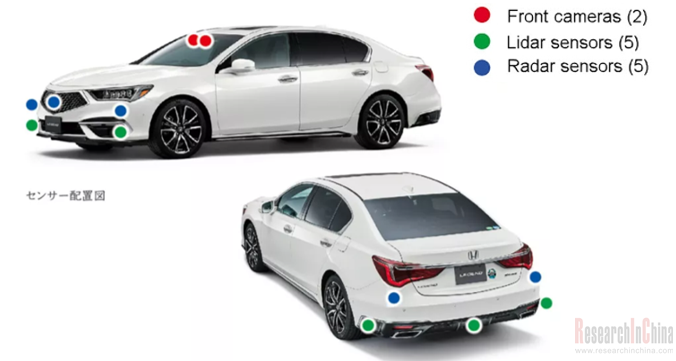
The composition of Honda SENSING Elite is as follows.
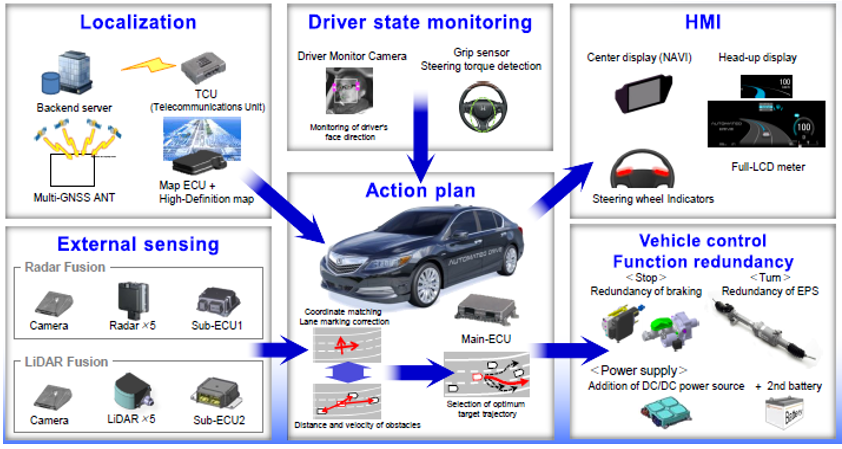
Honda Legend, the world’s first L3 autonomous model legally running on roads, is only available in Japan. Just 100 units have been launched on market for rental, not sold. The MRRP of JPY11 million (approximately RMB660,000) refers to only deposit. There is still no effective way for ordinary users to access L3 automated driving.
In December 2021, Mercedes-Benz DRIVE PILOT, a L3 autonomous driving system captured the approval for driving on roads from the German Federal Motor Transport Authority (KBA). This L3 system mounted on Mercedes-Benz EQS or S-Class will become available on market in 2022, which means ordinary users will use L3 autonomous driving function on 13,000km highways in Germany as early as the second half of 2022.
The sensor solution for Mercedes-Benz DRIVE PILOT is as follows:
- 1 LiDAR
- 4 angular radars
- 1 long-range forward radar
- 1 set of front view stereo cameras
- 4 surround view cameras
- 12 ultrasonic radars
- 1 wheel camera (working together with the rain sensor on the windshield to perceive whether it is rainy or not)
- 1 rear multi-purpose camera
- HD map
- Driver camera
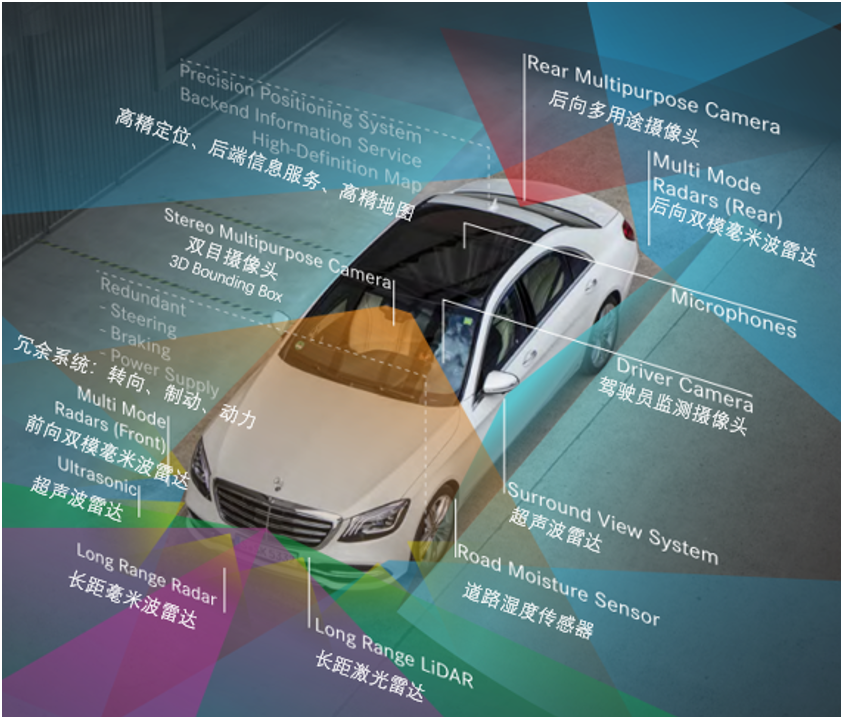
The KBA has granted approval for Mercedes-Benz’s mass-production and sales of L3 autonomous cars on the basis of the technical regulation UN-R157, a UN Regulation on uniform provisions concerning the approval of vehicles with Regards to Automated Lane Keeping Systems, which was passed at World Forum for Harmonization of Vehicle Regulations of United Nations Economic Commission for Europe.
UN-R157 defines ALKS:
 ALKS is a system than controls the lateral and longitudinal movement of the vehicle in the lane for extended periods without further driver command;
ALKS is a system than controls the lateral and longitudinal movement of the vehicle in the lane for extended periods without further driver command;
 Limit to passenger cars (M1 vehicles);
Limit to passenger cars (M1 vehicles);
 Limit to operational speed to 60 km/h maximum.
Limit to operational speed to 60 km/h maximum.
According to UN-R157 regulation, Mercedes-Benz DRIVE PILOT specifies that there is 10 seconds for the driver to disengage after sending the transition demand, a milestone in the history of “full disengagement of autonomous vehicle drivers”.
UN-R157, the world’s first binding international regulation on SAE L3 automation, has entered into force on January 22, 2021. Noticeably, the contracting states include states of the EU, UK, Japan, Korea and Australia. UN-R157 will provide reliable guidelines for automakers to develop L3 autonomous driving functions in major global markets.
GM and Ford among others will achieve L4 autonomous driving in 2022 at the earliest.
Volkswagen, GM, Ford and the likes develop L4 autonomous driving technologies by establishing subsidiaries or investing technology firms. They plan to first implement commercial L4 in online ride-hailing and logistics distribution.
Volkswagen will develop a new software platform in 2025 to support L4 autonomous driving, through its software subsidiary CARIAD (formerly known as Car.Software). In addition to CARIAD, Volkswagen and its investee Argo AI partnered and plan to achieve fully autonomous driving in 2025.
Cruise Origin, a fourth-generation L4 self-driving car co-launched by GM and its subsidiary Cruise, eliminates the steering wheel, accelerator and brake pedals and features layout of two bench seats that face inward. The car is projected to be spawned at Detroit-Hamtramck Assembly Plant starting in 2022.
In October 2020, Ford and Argo AI together unveiled a fourth-generation self-driving test vehicle refitted from Ford Escape Hybrid. They plan launch of the commercial autonomous service for online ride-hailing and logistics distribution in 2022.
Autonomous Driving Domain Controller and Central Computing Unit (CCU) Industry Report, 2025
Research on Autonomous Driving Domain Controllers: Monthly Penetration Rate Exceeded 30% for the First Time, and 700T+ Ultrahigh-compute Domain Controller Products Are Rapidly Installed in Vehicles
L...
China Automotive Lighting and Ambient Lighting System Research Report, 2025
Automotive Lighting System Research: In 2025H1, Autonomous Driving System (ADS) Marker Lamps Saw an 11-Fold Year-on-Year Growth and the Installation Rate of Automotive LED Lighting Approached 90...
Ecological Domain and Automotive Hardware Expansion Research Report, 2025
ResearchInChina has released the Ecological Domain and Automotive Hardware Expansion Research Report, 2025, which delves into the application of various automotive extended hardware, supplier ecologic...
Automotive Seating Innovation Technology Trend Research Report, 2025
Automotive Seating Research: With Popularization of Comfort Functions, How to Properly "Stack Functions" for Seating?
This report studies the status quo of seating technologies and functions in aspe...
Research Report on Chinese Suppliers’ Overseas Layout of Intelligent Driving, 2025
Research on Overseas Layout of Intelligent Driving: There Are Multiple Challenges in Overseas Layout, and Light-Asset Cooperation with Foreign Suppliers Emerges as the Optimal Solution at Present
20...
High-Voltage Power Supply in New Energy Vehicle (BMS, BDU, Relay, Integrated Battery Box) Research Report, 2025
The high-voltage power supply system is a core component of new energy vehicles. The battery pack serves as the central energy source, with the capacity of power battery affecting the vehicle's range,...
Automotive Radio Frequency System-on-Chip (RF SoC) and Module Research Report, 2025
Automotive RF SoC Research: The Pace of Introducing "Nerve Endings" such as UWB, NTN Satellite Communication, NearLink, and WIFI into Intelligent Vehicles Quickens
RF SoC (Radio Frequency Syst...
Automotive Power Management ICs and Signal Chain Chips Industry Research Report, 2025
Analog chips are used to process continuous analog signals from the natural world, such as light, sound, electricity/magnetism, position/speed/acceleration, and temperature. They are mainly composed o...
Global and China Electronic Rearview Mirror Industry Report, 2025
Based on the installation location, electronic rearview mirrors can be divided into electronic interior rearview mirrors (i.e., streaming media rearview mirrors) and electronic exterior rearview mirro...
Intelligent Cockpit Tier 1 Supplier Research Report, 2025 (Chinese Companies)
Intelligent Cockpit Tier1 Suppliers Research: Emerging AI Cockpit Products Fuel Layout of Full-Scenario Cockpit Ecosystem
This report mainly analyzes the current layout, innovative products, and deve...
Next-generation Central and Zonal Communication Network Topology and Chip Industry Research Report, 2025
The automotive E/E architecture is evolving towards a "central computing + zonal control" architecture, where the central computing platform is responsible for high-computing-power tasks, and zonal co...
Vehicle-road-cloud Integration and C-V2X Industry Research Report, 2025
Vehicle-side C-V2X Application Scenarios: Transition from R16 to R17, Providing a Communication Base for High-level Autonomous Driving, with the C-V2X On-board Explosion Period Approaching
In 2024, t...
Intelligent Cockpit Patent Analysis Report, 2025
Patent Trend: Three Major Directions of Intelligent Cockpits in 2025
This report explores the development trends of cutting-edge intelligent cockpits from the perspective of patents. The research sco...
Smart Car Information Security (Cybersecurity and Data Security) Research Report, 2025
Research on Automotive Information Security: AI Fusion Intelligent Protection and Ecological Collaboration Ensure Cybersecurity and Data Security
At present, what are the security risks faced by inte...
New Energy Vehicle 800-1000V High-Voltage Architecture and Supply Chain Research Report, 2025
Research on 800-1000V Architecture: to be installed in over 7 million vehicles in 2030, marking the arrival of the era of full-domain high voltage and megawatt supercharging.
In 2025, the 800-1000V h...
Foreign Tier 1 ADAS Suppliers Industry Research Report 2025
Research on Overseas Tier 1 ADAS Suppliers: Three Paths for Foreign Enterprises to Transfer to NOA
Foreign Tier 1 ADAS suppliers are obviously lagging behind in the field of NOA.
In 2024, Aptiv (2.6...
VLA Large Model Applications in Automotive and Robotics Research Report, 2025
ResearchInChina releases "VLA Large Model Applications in Automotive and Robotics Research Report, 2025": The report summarizes and analyzes the technical origin, development stages, application cases...
OEMs’ Next-generation In-vehicle Infotainment (IVI) System Trends Report, 2025
ResearchInChina releases the "OEMs’ Next-generation In-vehicle Infotainment (IVI) System Trends Report, 2025", which sorts out iterative development context of mainstream automakers in terms of infota...